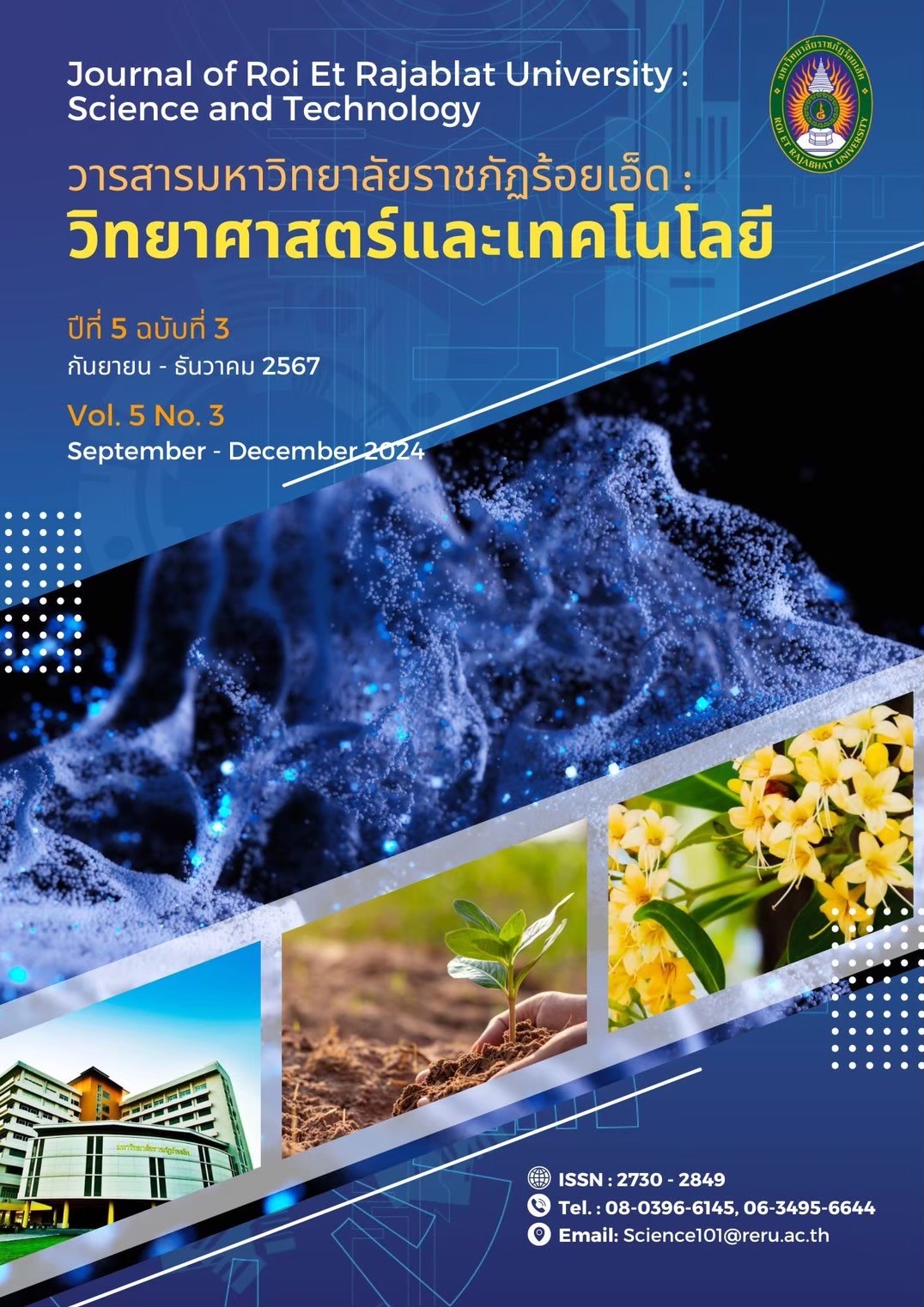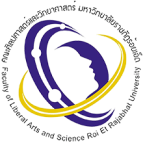Efficiency of Flavonoids of Dalbergia parviflora Roxb against Escherichia coli TISTR 527
Keywords:
Dalbergia parviflora, Antibacterial activity, Flavonoid, Escherichia coliAbstract
Isolation from methanolic extract of stems of Dalbergia parviflora Roxb by chromatographic techniques gave four known flavonoids: pinocembrin (I), naringenin (II), biochanin A (III), and sativanone (IV). All isolates were characterized by spectroscopic techniques including IR and 1H and 13C NMR. The antibacterial activity against Escherichia coli TISTR 527 was carried out by broth dilution assay and determined both minimal inhibitory concentration (MIC) and minimum bactericidal concentration (MBC) of all isolated substances. The results showed that the MIC and MBC of pinocembrin (I) were found to be highly sensitive 17.19 and 137.5 µg/mL, respectively.
References
Boongapim, R., Ponyaim, D., Phiwthong, T., & Rattanasuk, S. (2021). In vitro antibacterial activity Capparis sepiaria. against human pathogenic bacteria. Asian Journal of Plant Sciences, 20, 102-108-222. DOI: 10.3923/ajps.2021.102.108
Chan, S. C., Chang, Y. S., Wang, J. P., Chen, S. C., & Kuo, S. C. (1998). Three new flavonoids and antiallergic, anti-inflammatory constituents from the heartwood of Dalbergia paviflora. Planta Med, 64(2), 153-158. DOI: 10.1055/s-2006-957394
Choi, S. Y., Ha, T. Y., Ahn, J. Y., Kim, S. R., Kang, K. S., Hwang, I. K., & Kim S. (2008). Estrogenic activities of isoflavones and flavones and their structure-activity relationships. Planta Med. 74(1), 25-32. DOI: 10.1055/s-2007-993760
El-Mahdy, M. A., Zhu, Q., Wang, Q. E., Wani, G., Patnaik, S., Zhao, Q., Arafa, S., Barakat, B., Mir, S. N., & Wani, A. A. (2008). Naringenin protects HaCaT human keratinocytes against UVB-induced apoptosis and enhances the removal of cyclobutane pyrimidine dimers from the genome. Photochem Photobiol 84(2), 307-316. DOI: 10.1111/j.1751-1097.2007.00255.x
Gao, M., Liu, R., Zhu, S. Y., & Du, G. H. (2019). Pinocembrin Protects from AGE-Induced Cytotoxicity and Inhibits Non-Enzymatic Glycation in Human Insulin. Cells. 8(5), 385. DOI: 10.3390/cells8050385
Hirai, S., Kim, Y. I., Goto, T., Kang, M. S., Yoshimura M., Obata, A., Yu, R., & Kawada, T. (2007). Inhibitory effect of naringenin chalcone on inflammatory changes in the interaction between adipocytes and macrophages. Life Sci. 81(16), 1272-1279. DOI: 10.1016/j.lfs.2007.09.001
Liu, R. X., Li, L., Wang, Q., Wang, W., Bi, K.S., & Guo, D. A. (2005). Simultaneous determination of nine flavonoids in Dalbergia odorifera by LC. Chromatographia, 61, 409-413. https://link.springer.com/article/10.1365/s10337-005-0520-0
Meesup, P., & Buachard, S. (2018). Efficiency of plant extracts against Staphylococcus aureus and Escherichia coli. Agricultural Sci. J. 49(2), 485-488. https://research.kpru.ac.th/research2/pages/filere/2132019-09-05.pdf
Pichiansunthorn, C., Chavalit, M., & Jeerawong, V. (1999). Text Book of Medicinal Plants. Bangkok: Amarin Printing and Publishing.
Promden, W., Monthakantirat, O., Umehara, K., Noguchi, H., & De-Eknamkul, W. (2014). Structure and Antioxidant Activity Relationships of Isoflavonoids from Dalbergia parviflora. Molecules. 19(2), 2226-2237. https://doi.org/10.3390/molecules19022226
Rattanasuk, S., and Phiwthong, T. (2021). A new potential source of anti-pathogenic bacterial sunstances from Zamioculcas zamiifolia (Lodd.) Engl. Extracts. Pakistan Journal of Biological Sciences:PJBS, 24(2), 235-240. DOI: 10.3923/pjbs.2021.235.240
Smitinand, T. (1983). Valuable Economic Plants in Thailand Part III. The Forest Herbarium. Bangkok, Thailand: Royal Forest Department.
Songsiang, U., Hahnvajanawong, C., & Yenjai, C. (2011). Cytotoxicity of chemical constituents from the stems of Dalbergia parviflora. Fitoterapia. 82, 1169-1174. https://doi.org/10.1016/j.fitote.2011.07.015
Umehara, K., Nemoto, K., Matsushita, A., Terada, E., Monthakantirat, O., De-Eknamkul, W., Miyase, T., Warashina, T., Degawa, M., & Noguchi, H. (2009). Flavonoids from the heartwood of the Thai medicinal plant Dalbergia paviflora and their effects on estrogenic-responsive human breast cancer cells. Journal of Natural Products. 72(12), 2163-2168. https://doi.org/10.1021/np900676y
Wang, Y., Gho, W. M., Chan, F. L., Chen, S., & Leung, L. K. (2008). The red clover (Trifolium pratense) isoflavone biochanin A inhibits aromatase activity and expression. Br J Nutr. 99(2), 303-310. DOI:10.1017/S0007114507811974
Wongjiratthiti, A., Yottakot, S., Duangsupha, W., Saenmuang, S., & Hemtasin, C. (2019). Antimicrobial activity of medicinal plant extracts against food spoilage microorganisms. KHON KAEN AGR. J. 47(SUPPL. 1), 1651-1656. https://ag2.kku.ac.th/kaj/PDF.cfm?filename=168_Pat12.pdf&id=3641&keeptrack=9
Downloads
Published
Versions
- 2025-02-24 (3)
- 2025-02-22 (2)
- 2024-09-05 (1)
How to Cite
Issue
Section
License
Copyright (c) 2024 Faculty of Liberal Art and Science, Roi-Ed Rajabhat University

This work is licensed under a Creative Commons Attribution-NonCommercial-NoDerivatives 4.0 International License.
บทความที่ได้รับการตีพิมพ์เป็นลิขสิทธิ์ของคณะศิลปศาสตร์และวิทยาศาสตร์ มหาวิทยาลัยราชภัฏร้อยเอ็ด
ข้อความที่ปรากฏในบทความแต่ละเรื่องในวารสารวิชาการเล่มนี้เป็นความคิดเห็นส่วนตัวของผู้เขียนแต่ละท่านไม่เกี่ยวข้องกับมหาวิทยาลัยราชภัฎร้อยเอ็ด และคณาจารย์ท่านอื่นๆในมหาวิทยาลัยฯ แต่อย่างใด ความรับผิดชอบองค์ประกอบทั้งหมดของบทความแต่ละเรื่องเป็นของผู้เขียนแต่ละท่าน หากมีความผิดพลาดใดๆ ผู้เขียนแต่ละท่านจะรับผิดชอบบทความของตนเองแต่ผู้เดียว





